
RICARDO
VILLALBA
JOSÉ
A. BONINSEGNA
SILVIA DELGADO
Departamento de Dendrocronología e Historia Ambiental, IANIGLA – CONICET, Mendoza, Argentina
ANTONIO
LARA
Instituto de Silvicultura,
Universidad Austral de Chile, Valdivia, Chile
Abstract
A tree-ring chronology network recently developed from the subantarctic forests provides an opportunity to study long-term climatic variability at higher latitudes in the South American sector of the Southern Ocean. Based on the longest pressure records available in the South American-Antarctic Peninsula (SAAP) sector of the Southern Oceans, zonal and meridional indices have been developed for the region. Temperature records in southern South America and the Antarctic Peninsula are strongly affected by the strength of the meridional flow, whereas precipitation variations along the Pacific coast in southern South America are more related to changes in the zonal circulation at higher latitudes. We employed dendroclimatic techniques for reconstructing both the zonal (ZSAAP) and the meridional (MSAAP) circulation indices over the past four centuries. The ZSAAP reconstruction shows dominant modes of variation at around 4.4 and 5 years, which may be associated with the proposed Antarctic Circumpolar Wave in the Southern Oceans. Contrasting patterns in meridionality during the past two centuries are observed in the MSAAP reconstruction. Since the mid 1950s the northerly flow has steady increased, reaching unprecedented levels during the 1980s in the context of the past 400 years.
Corresponding author address: Ricardo Villalba, Departamento de Dendrocronología e Historia Ambiental, IANIGLA – CONICET, C.C. 330, (5500) Mendoza, Argentina. E-mail: ricardo@lab.cricyt.edu.ar
1. Introduction
The Antarctic sea ice region, which fluctuates dramatically in albedo and heat exchange with the atmosphere, strongly influences the oceanic and atmospheric circulation in middle and lower southern latitudes (Budd 1991, Carleton 1992). In spite of major climatic role of the Antarctic continent in the Southern Hemisphere, the scarcity and shortness of the available meteorological records at high southern latitudes have hampered any study of long-term changes in the atmospheric circulation over Antarctica and the Southern Ocean.
No tree-ring based climate
reconstructions exist for the high latitudes (>55°S) of the Southern
Hemisphere. Indeed, the continuity of the Southern Ocean between nearly 50 and
65°S, and the extreme climate conditions prevailing in Antarctica limit
the distribution of forests south of Tierra del Fuego, and consequently the
availability of tree-ring records.
Recent developments in
chronology networks have occurred in mid- to relatively high-latitudes (35-55°S)
in southern South America (Boninsegna 1992; Boninsegna and Villalba 1996; Villalba
2000). With the increasing number of tree-ring collections from climatically
sensitive areas in southern South America, the use of a spatial approach to
study large-scale atmospheric variations connecting mid- to high-latitude climatic
changes appears now to be feasible. A key incentive for this exercise is the
documented existence of teleconnections relating climatic variations between
middle and high latitudes in the Southern Hemisphere (Pittock 1984; Carleton
1992; van Loon et al. 1993; Karoly et al. 1996).
In this contribution we
reviewed the most recent dendroclimatological research intended to evaluate
the atmosphere-ocean climatic changes at high latitudes in southern South America
over the past centuries. Instrumental records were used to characterize the
patterns of zonal and meridional flow at high latitudes in the South America-Antarctic
Peninsula sector of the Southern Ocean during the 20th century. Next, we combine
these data with high-resolution tree-ring records to provide a long-term perspective
for the climatic variations that have occurred more recently. Tree-ring based
reconstructions of pressure gradients are used to infer changes in the zonal
and meridional flows during the past 400 years across the southern South America-Antarctic
Peninsula region.
2. High latitude indices
of the atmospheric circulation in the Southern Hemisphere
Differences in sea-level
pressure between pairs of stations have traditionally been used as indices of
the large-scale atmospheric circulation (Lamb 1977). The Trans-Polar Index (TPI),
defined as the difference in sea-level pressure between Hobart, Tasmania (43°S
147°E) and Stanley, South Atlantic Ocean (52°S 58°W), was proposed
by Pittock (1980) to measure the eccentricity of the polar vortex around the
South Pole (Fig. 1). The selection of these two sites may not be optimal, however.
It has been noted that the strength of atmospheric teleconnections between the
South American and Australasian sectors depends on seasonality as well as the
time interval considered (Carleton 1989; Villalba et al. 1997). An alternative
index, the Summer Trans-Polar Index (STPI, Fig. 1), was developed by Villalba
et al. (1997). STPI is defined as the difference between the normalized averages
of five stations over New Zealand (Wellington, Christchurch, Hokitika and Dunedin
on the South Island and Chatham Island) and three stations in the southwestern
Atlantic (Grytviken on South Georgia, and Orcadas and Signy on the South Orkney
Islands). Selection of these two sets of stations was made based on a correlation
analysis of sea-level pressure records from 50 stations in the Southern Hemisphere
located between 15† and 65†S. During summer, the strongest spatial teleconnection
in the mean sea-level pressure (MSLP) field occurs between the southern South
America-Antarctic Peninsula and New Zealand sectors of the Southern Hemisphere
(Villalba et al. 1997).
Atmospheric circulation indices at mid- to high-latitudes in the Southern Hemisphere have been developed, at regional scale, over the Tasman Sea-New Zealand and South America-Antarctic Peninsula sectors. Circulation indices in the South American-Antarctic Peninsula (SAAP) sector have been less extensively studied than in the New Zealand sector. Recently, Jones et al. (1999) redefined zonal and meridional indices for the SAAP region. The zonal index (ZSAAP), originally proposed by Mayes (1985), is defined as the anomalous pressure difference between Stanley (51.46°S, 57.59°W) and Orcadas (60.70°S, 44.70°W). The meridional index (MSAAP) results from differences in anomalous pressure between Punta Arenas (53.09°S, 70.48°W) and Stanley (Fig. 1). ZSAAP is a measure of the zonal westerlies between approximately 51° and 60°S, while MSAAP measures meridionality across southern South America (58°W to 71°W).

FIG. 1. Maps of the Southern
Hemisphere and the southern South America-Antarctic Peninsula (upper left corner)
showing the geographical setting for the Summer Trans-Polar Index (STPI), the
South America-Antarctic Peninsula Zonal Index (ZSAAP), and the South America-Antarctic
Peninsula Meridional Index (MSAAP). Abbreviations for meteorological stations
are ORC: Orcadas, SIG: Signy Island, GRY: Grytviken, STA: Stanley, and PTA:
Punta Arenas, in the South American-Antarctic Peninsula sector of the Southern
Ocean, and WEL: Wellington, HOK: Hokitika, CHR: Christchurch, DUN: Dunedin,
CHA: Chatham Island, and HOR: Hobart in the Australia-New Zealand region. Locations
of tree-ring chronologies across the Southern Andes are indicated by solid triangles:
(s) Austrocedrus chilensis, (s) Fitzroya cupressoides, and (s) Nothofagus pumilio.
3. Interactions between
high-latitude circulation indices
Relationships between hemispheric
and regional forcings of climatic variability were explored by correlating the
Trans-Polar Index with the zonal and meridional pressure gradients for the South
American sector of the Southern Ocean. Significant correlations during the 20th
century occur between the STPI and ZSAAP. It has been noted that changes in
the circulation across Antarctic contribute to the interannual variability of
the westerlies. When the STPI is positive (displaced in relation to its average
position towards the South America), the westerlies intensify in the 50-60°S
band across the South American sector of the Southern Ocean. Positive relationships
are also observed between STPI and MSAAP in summer (Fig. 2). Positive values
of STPI are associated with dominant southerly winds during summer across southern
South America. This relationship was more consistent during the first half of
the 20th century.
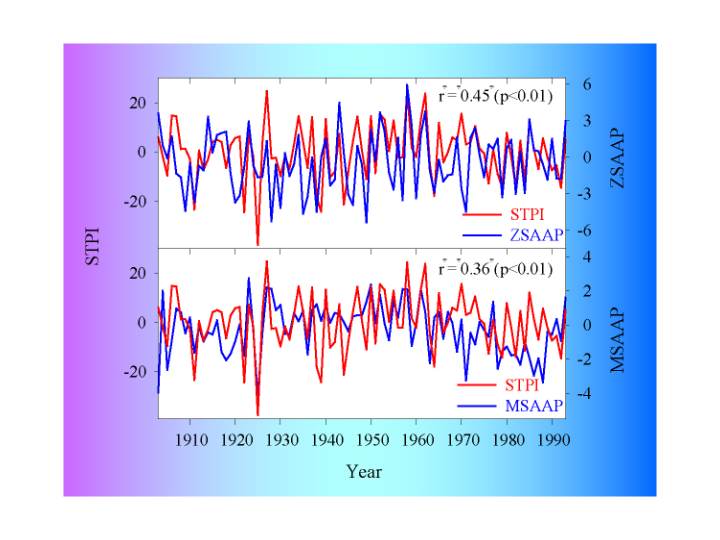
FIG. 2. Comparison of interannual variations in summer (December to February)
departures of the Summer Trans-Polar Index (STPI) with zonal (ZSAAP) and meridional
(MSAAP) pressure gradients in southern South America-Antarctic Peninsula.
To assess the importance of the high-latitude atmospheric circulation on climate
variability in southern South America, we correlated the ZSAAP and MSAAP circulation
indices with temperature and precipitation records south of 15°S. Temperature
records in southern South America and Antarctic Peninsula are strongly affected
by the strength of the MSAAP, whereas regional precipitation variations are
more related to changes in the ZSAAP (Fig. 3).
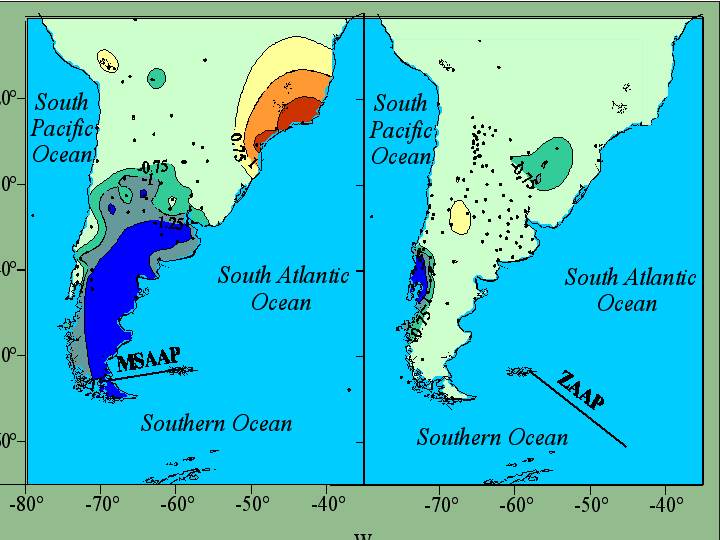
FIG. 3. Spatial patterns
of correlation ratios between individual annual mean temperature (left) and
total annual precipitation (right) records in Argentina, Chile, Brazil, Bolivia,
Paraguay and Uruguay, and the circulation indices MSAAP and ZSAAP, respectively.
The correlation ratios result from the ratio between the correlation coefficient
(r) and the corresponding critical value of r for a confidence level _ = 0.05.
Ratios greater than 1 correspond to significant correlations at 95% confidence
level between indexes and stations. Data used include 64 and 136 records for
temperature and precipitation, respectively. Meteorological stations are indicated
by dots(•).
4. Tree-ring records
Tree-ring predictors of
the zonal and meridional pressure gradients were selected based on the current
relationships between circulation indices and regional climate. The spatial
correlation patterns between circulation indices and regional climate shown
in Figure 3 were instrumental in our setting the strategies for selecting tree-ring
records sensitive to fluctuations in the zonal and meridional indices. The tree-ring
records used for reconstructing the zonal index (ZSAAP) include a combination
of eight precipitation-sensitive chronologies from the tree species Austrocedrus
chilensis and Fitzroya cupressoides along the northern Patagonian Andes. On
the other hand, the set of predictors used for reconstructing past variations
in meridional circulation includes three upper-elevation Nothofagus chronologies
located in Patagonia south of 40°S.
TABLE 1. Site characteristics
for the composite tree-ring chronologies.
| Code | Sites included | Species | Lat. (ƒS) | Long. (ƒW) | Elev. (m) |
| AUS1 | ‹orquinco | Austrocedrus chilensis | 39ƒ07' | 71ƒ07' | 1150 |
| Rucachoroi | Austrocedrus chilensis | 39ƒ15' | 71ƒ10' | 1300 | |
| QuillÈn | Austrocedrus chilensis | 39ƒ17' | 71ƒ16' | 1100 | |
| AUS2 | Collun-co Alto | Austrocedrus chilensis | 39ƒ56' | 71ƒ08' | 870 |
| C. La Hormiga | Austrocedrus chilensis | 40ƒ03' | 71ƒ17' | 920 | |
| C. Los Pinos | Austrocedrus chilensis | 40ƒ04' | 71ƒ02' | 1100 | |
| AUS3 | C. Los Leones | Austrocedrus chilensis | 41ƒ05' | 71ƒ09' | 1020 |
| C. Los Leones | Austrocedrus chilensis | 41ƒ05' | 71ƒ09' | 1020 | |
| AUS4 | Est. Teresa | Austrocedrus chilensis | 42ƒ57' | 71ƒ14' | 820 |
| Nahuel-Pan | Austrocedrus chilensis | 42ƒ58' | 71ƒ13' | 850 | |
| FIT1 | RÌo FrÌas | Fitzroya cupressoides | 41ƒ06' | 71ƒ48' | 950 |
| RÌo Alerce | Fitzroya cupressoides | 41ƒ10' | 71ƒ47' | 1100 | |
| FIT2 | Los Quetros | Fitzroya cupressoides | 40ƒ50' | 72ƒ20' | 900 |
| Puntiagudo | Fitzroya cupressoides | 40ƒ55' | 72ƒ21' | 970 | |
| V. Osorno | Fitzroya cupressoides | 41ƒ10' | 72ƒ30' | 990 | |
| FIT3 | Lenca | Fitzroya cupressoides | 41ƒ33' | 72ƒ36' | 875 |
| Patamay | Fitzroya cupressoides | 41ƒ52' | 72ƒ32' | 875 | |
| Contao | Fitzroya cupressoides | 41ƒ53' | 72ƒ38' | 975 | |
| Pichicolo | Fitzroya cupressoides | 41ƒ56' | 72ƒ25' | 700 | |
| FIT4 | L. Inexplorado | Fitzroya cupressoides | 41ƒ57' | 72ƒ17' | 1000 |
| Ayacara | Fitzroya cupressoides | 42ƒ16' | 72ƒ46' | 800 | |
| COV6 | Tronador | Nothofagus pumilio | 41ƒ10' | 71ƒ48' | 1480 |
| NOT1 | C. Oportus | Nothofagus pumilio | 47ƒ08' | 71ƒ56' | 930 |
| C. Tamango | Nothofagus pumilio | 47ƒ10' | 72ƒ30' | 1060 | |
| GPB | Piedras Blancas | Nothofagus pumilio | 49ƒ21' | 72ƒ58' | 650 |
5. Tree-ring reconstructions
of circulation indices
We used principal component
regression (Cooley and Lohnes 1971) to orthogonalize the inter-correlated set
of chronologies (predictors) and reduce the dimension of the regression analysis
by eliminating the high-order eigenvectors that account for very little variance.
Only eigenvectors showing eigenvalues >1 were retained in the model. Tree
growth in any particular yr (t) can be influenced by climate in the current
and previous year. This lag effect in the relationships between climate and
tree growth is particularly evident in Fitzroya cupressoides. Previous studies
have shown that radial growth of Fitzroya cupressoides is more strongly associated
with climatic conditions in the previous than in the current growing season
(Villalba 1990; Lara and Villalba 1993). Consequently, the zonal and meridional
circulation indices in year t were modeled as a function of tree growth in the
years t, t+1, t+2, and t+3. We used the Mallow's Cp criterion, a measure of
the tradeoff between the goodness-of-fit of the regression and the number of
predictors in the model (Draper and Smith 1981), to select the best-fit regression
models.
Cross-validation tests
for the ZSAAP and MSAAP regression models were next performed for the intervals
1910-1989 and 1913-1989, respectively. We divided the zonal and meridional records
into two intervals, using the first 50 years (1910-1959 and 1913-1962 respectively)
for calibration and reserving the most recent decades of each record for verification.
We then reversed the process, selecting the most recent 50 years (1940-1989)
for calibration and withholding the earliest years for verification. Finally,
the entire common intervals between the ZSAAP and MSAAP indices and the tree-ring
series were used to derive the final regression equations used to develop the
ZSAAP and MSAAP index reconstructions. Utilization of the longest possible calibration
interval enhances the ability of the regression models to reconstruct low-frequency
variability in both reconstructions.
For the ZSAAP index, the
regression equation explained 42.2 % of the total variance in the October-March
pressure gradient between Stanley and Orcadas over the calibration interval
from 1910-1989 (Fig. 4). Correlations between observed and predicted values
for the independent, cross-validation periods were significant. The reduction
of error statistics is highly positive, indicating useful skill in the regressions
(Gordon and LeDuc 1981).
Regression equations for
the summer (November to February) MSAAP index explained 44.4% of the total variance
in the Punta Arenas-Stanley pressure gradient for the 1913-1989 calibration
interval (Fig. 4). The verification statistics indicate some skill in the reconstructions
of the MSAAP index during summer.
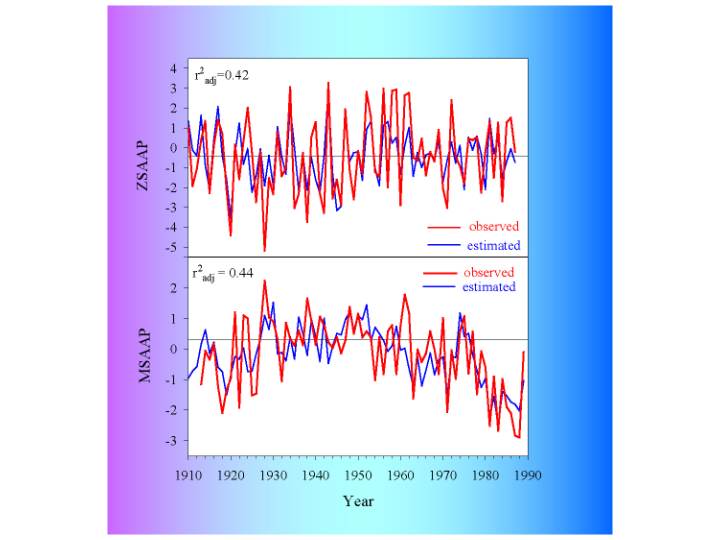
FIG. 4. Observed and estimated
anomalies for ZSAAP and MSAAP in summer across South America-Antarctic Peninsula
for the intervals 1910-1989 and 1913-1989, respectively.
The ZSAAP reconstruction
is largely dominated by high-frequency variations (Fig. 5), however, some periods
of persistent anomalies in the westerly flow between 50 and 60°S are observed.
Two of the five weakest non-overlapping intervals of 25 years in the zonal flow
(1918-1942 and 1963-1987) occurred during the 20th century. Conversely, none
of the five 25-year intervals with the strongest zonal flow during the past
four centuries was recorded in the 20th century. Based on these observations,
it looks like the zonal flow at southern latitudes was, on average, weaker during
the 20th century than in the three previous centuries.
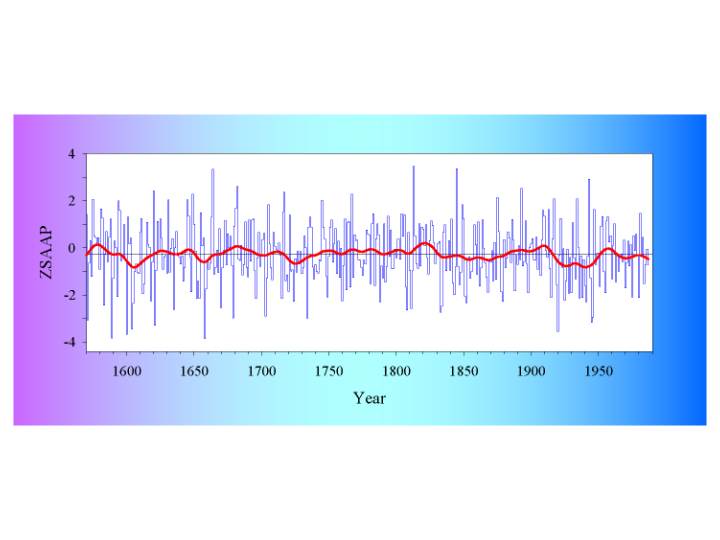
FIG. 5. Reconstructed variations
in summer zonal circulation (ZSAAP) in the South America-Antarctic Peninsula
sector of the Southern Ocean from 1570 to 1989.
In contrast to the ZSAAP,
the MSAAP reconstruction shows remarkable long-term oscillations in meridionality
across southern South America since 1630 (Fig. 6). Southerly winds were persistent
since 1640 to 1670, around 1740 and most years during the 19th century. The
two strongest long-term interval (25 years) of southerly flow during the past
370 years occurred during the 1800s (1850-1874 and 1808-1832). Two intervals
in the 20th century, 1965-1989 and 1902-1926, represent the strongest anomalies
of northerly flow over the past 4 centuries. Persistent northerly flow during
the 1980s has been unprecedented in the 370-yr record.
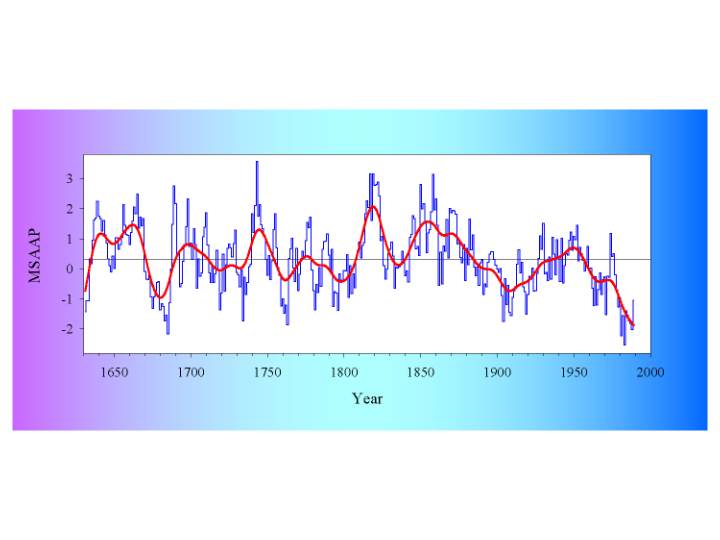
FIG. 6. Reconstructed variations
in summer meridional circulation (MSAAP) in the South America-Antarctic Peninsula
sector of the Southern Ocean from 1631 to 1989.
6. Spectral properties of the circulation index reconstructions
We used the Blackman-Tukey (BTM; Jenkins and Watts 1968) spectral technique
to establish the most significant dominant periods at which variance occur in
the ZSAAP and MSAAP reconstructions. The BTM spectrum for the reconstructed
ZSAAP shows that large part of the spectral power is concentrated at cycles
between 3.2 and 5 years in length. Low-frequency oscillations are also manifest
at 6.1, 8.9 and 18 years, but they more subdued than the 2-5 years oscillations.
In contrast to the ZSAAP
index, the MSAAP spectra show marked concentrations of the spectral power at
low frequencies (> 30 years). A prominent peak at 66-100 years is observed
in the BTM spectrum. Significant peaks (above the 95% confidence level) are
recorded for oscillations centered at 11.4 and 2.5 yr (Fig. 7).
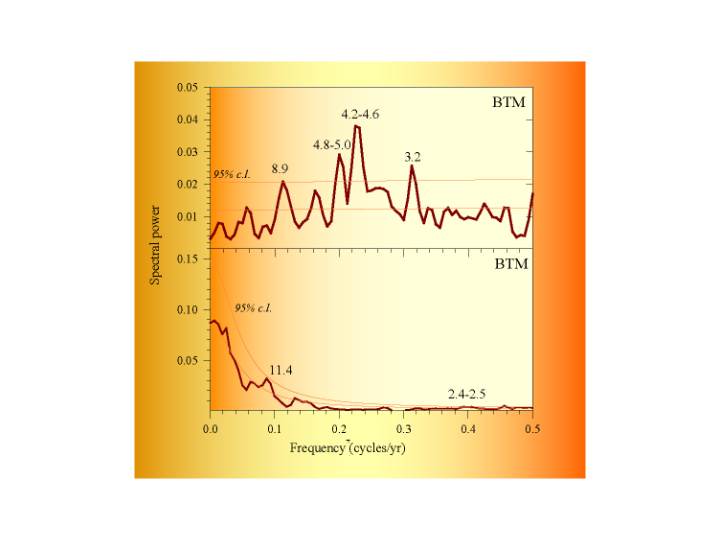
FIG. 7. Blackman-Tukey
(BTM) power spectra for the ZSAAP (upper) and MSAAP (lower) reconstructions.
The 95% confidence limits are based on a 1st-order Markov null continuum model.
The periods are given in years for the significant peaks.
7. Long-term interactions
between circulation indices
Decade- to century-scale
interactions between major atmospheric features in the South American sector
of the Southern Ocean were investigated using the tree-ring based reconstructions
of atmospheric pressure gradients in the South America-Antarctic Peninsula sector.
Correlation coefficients of successive subinterval of 50-yr in length between
reconstructions show remarkable changes in the relationships between STPI and
ZSAAP. Deteriorations during the 19th century in the relationships between extra-tropical
circulation indexes emerge from most comparisons (Fig. 8). In most cases, relationships
during the second half of the 18th century improve, reaching significance levels
similar to those observed in the 20th century. We speculate that circulation
patterns at higher latitudes during the 19th century might have been different
from those recorded during the instrumental period. The strongest southerly
flow across the region in the past 400 years was concurrent with the climatic
anomalies in the 1800s (Fig. 8).

FIG. 8. Long-term interactions between regional and hemispheric circulation
indexes were evaluated using (c) moving Pearson correlation coefficients between
the STPI and ZSAAP plotted on the centroids of 50-year periods. Slanted lines
indicate the interval, during the 19th century, characterized by changes in
the correlation patterns between STPI and ZSAAP, and by the occurrence of persistently
high MSAAP values (dominant southerly flow).
8 . Discussion
Several environmental changes
have occurred in southern South America and the Antarctic Peninsula that are
consistent with the increasing northerly flow during the recent decades. Abrupt
warming trends have been documented in most station temperature records south
of 45°S in South America (Rosenblutt et al., 1997) and in the Antarctic
Peninsula (King, 1994). Extensive ablation has been observed on the Andean glaciers
(Casassa et al. 1997, 2000) and on low altitude glaciers and small ice caps
on the Antarctic Peninsula (Splettstoesser 2000).
The anomalous northerly flow during the past few decades may be also related
to documented increase in sea surface temperature (SST) in the southern SAAP
region. To assess the importance of the meridional circulation on the long-term
increase in sea surface temperature around southern South America, we correlated
the MSAAP index reconstructions with annual (April to March) sea surface temperature
in the South Pacific and South Atlantic oceans (Fig. 9). Statistically significant
correlations are observed all around southern South America southward of 40°S,
reflecting the concomitant increase in SST and northerly flow during the past
decades.
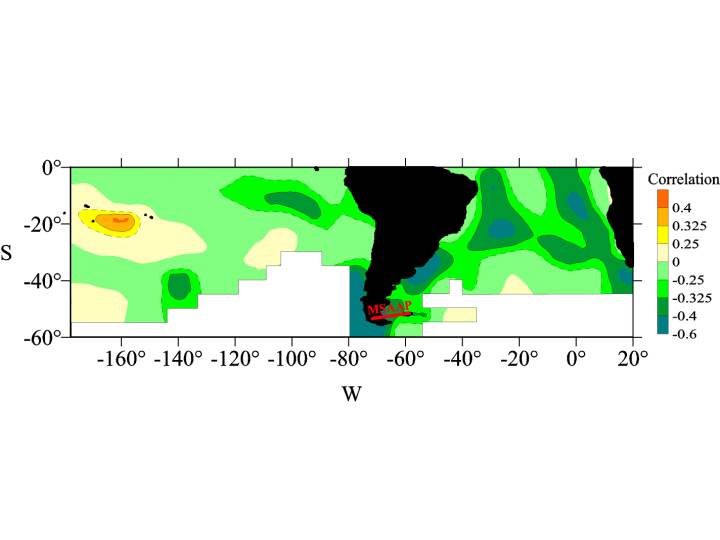
FIG. 9. Spatial correlation patterns during the interval 1930-1989 between annual SST (on 5° lat. x 5° long. grid) anomalies over the South Pacific and South Atlantic Oceans and the reconstructed MSAAP index. SST records, on 5° latitude x 5° longitude grids, were obtained from Kaplan et al. (1997).
The BTM spectrum of ZSAAP
reconstruction indicate that the most significant oscillatory modes are centered
at 4.4 and 5 yr (Fig. 7). Interestingly, it has been shown that local signals
in fields of SST, MSLP, meridional winds, and sea ice extent around Antarctica
have a periodicity of 4-5 years. This oscillation, termed the Antarctic Circumpolar
Wave (ACW), is manifest by an eastward propagation signal in both oceanic and
atmospheric variables of the high latitudes southern latitudes (White and Peterson,
1996). In view of the very short observational records in this data-sparse region,
it may be somewhat surprising that a reconstruction of zonal flow across the
southern ocean can capture a a consistent 4-5 year oscillatory mode over the
past four centuries. Our results suggests that the ACW patterns observed for
the 1980s and 1990s represent a stable mode of interannual variability that
has not been strongly modified or supplanted by other modes, at least during
the past 400 years.
The long-term perspective
provide by our reconstructions have important implications in relation to our
knowledge of climate variability at southern latitudes. Have the circulation
modes of variability revealed by the analysis of the instrumental records prevailed
during the past 400 years? Or there are other important modes of variability
inherent to the higher latitudes that have not been exposed by the fragmentary
and sparse network of climate records in the southern oceans? Whereas the ZSAAP
reconstruction provides support for a persistent 4-5 year cycle in the westerly
flow, impressive changes in meridional circulation are inferred from the MSAAP
reconstruction during the past 400 years. Interactions between regional and
hemispheric circulation indexes have certainly changed in the past.
Acknowledgements.
This research was partially supported by the Argentinean Agency for Promotion
of Science and Technology (PICT 07-03093) and the CRN03 project of the Inter
American Institute for Global Change Research. LLILAS support to R. Villalba
through the Resource Professor Program at the University of Texas, Austin, is
gratefully acknowledged.
References
Boninsegna, J.A., 1992:
South American dendroclimatological records. In Bradley, R.S., Jones, P.D. (eds),
Climate since A.D. 1500, Routledge, London pp. 446-462.
Boninsegna, J.A., and R. Villalba, 1996: Dendroclimatology in the Southern Hemisphere:
Review and Prospect. In: Tree Rings, Environment and Humanity, J.S. Dean, D.M.
Meko, and T.W. Swetnam (eds.), pp. 127-141.
Budd, W.F., 1991: Antarctica and global change. Clim. Change, 18: 271-299.
Carleton, A.M. 1989: Antarctic sea-ice relationships with indices of the atmospheric
circulation of the Southern Hemisphere. Clim. Dyn., 2, 207-220
Carleton, A.M., 1992: Synoptic interactions between Antarctica and lower latitudes.
Aust. Met. Mag., 40, 129-147.
Casassa, G., H. Brecher, A. Rivera, and M. Aniya, 1997: A century-long record
of Glaciar O'Higgins, Patagonia. Annals of Glaciology, 24, 106-110.
Casassa, G., A. Rivera, and J.F. Carrasco, 2000: Glacier variations in the Southern
Patagonia Icefield and their relation with climate, Proceedings of the Sixth
International Conference on Southern Hemisphere Meteorology and Oceanography,
Amer. Met. Soc. 3-7 April 2000, Santiago, Chile, 312-313.
Cooley, W.W., and P.R. Lohnes, 1971: Multivariate data analysis. Wiley, New
York, USA.
Draper, N.R., and H. Smith, 1981: Applied regression analysis, John Wiley and
Sons, New York. 2nd edition.
Gordon, G.A., and S.K. LeDuc, 1981: Verification statistics for regression models,
In: Preprints Seventh Conference on Probability and Statistics in Atmospheric
Sciences, Am. Meteorol. Soc., Monterey, pp 129-133
Jenkins, G.M., and D.G. Watts, 1968: Spectral analysis and its applications.
Holden-Day, San Francisco. pp. 525.
Jones, P.D., M.J. Salinger, and A.B. Mullan, 1999: Extratropical circulation
indices in the Southern Hemisphere based on station data. Int. J. Climatol.
19: 1301-1317.
Kaplan, A., M.A. Cane, Y. Kushnir, B. Blumenthal, and B. Rajagopalan, 1997:
Analyses of global sea surface temperature 1856-1991. J. Geophys. Res., 101,
22599-22617.
Karoly, D.J., P. Hope, and P.D. Jones, 1996: Decadal variations of the Southern
Hemisphere circulation. Int. J. Climatol., 16, 723-738.
King, J.C., 1994: Recent climate variability in the vicinity of the Antarctic
Peninsula. Int. J. Climatol., 14, 357-369.
Lamb, H.H., 1977: Climate: Present, Past and Future, Vol. 2, Methuen, London.
Lara, A., and R. Villalba, 1993: A 3,620-year temperature reconstruction from
Fitzroya cupressoides tree rings in southern South America. Science, 260, 1104-1106.
Mayes, P.R. 1985: Secular variations in cyclonic frequencies near the Drake
passage, Southwest Atlantic. J. Geophys. Res., 90, 5829-5839.
Pittock, A.B., 1980: Patterns of climatic variation in Argentina and Chile.
I. Precipitation, 1931-1960, Mon. Weather. Rev. 108, 1347-1361.
Pittock, A.B., 1984: On the reality, stability, and usefulness of southern hemisphere
teleconnections. Aust. Meteor. Mag., 32: 75-82.
Rosenbluth, B., H.A. Fuenzalida, and P. Aceituno, 1997: Recent temperature variations
in southern South America. Inter. J. Climatology, 17, 67-85.
Splettstoesser, J., 1992: Antarctic global warning?, Nature, 355, 503.
van Loon, H., J.W. Kidson, and A.B. Mullan, 1993: Decadal variation of the annual
cycle in the Australian dataset. J. Climate, 6, 1227-1231.
Villalba, R. 1990: Climatic fluctuations in Northern Patagonia during the last
1000 years as inferred from tree-ring records. Quaternary Research, 34, 346-360.
Villalba, R. 2000: Dendroclimatology: a Southern Hemisphere Perspective. In:
Paleo- and Neoclimates of the Southern Hemisphere: the state of the arts. P.
Smolka and W. Volkheimer (eds.). Springer. pp. 105-143.
Villalba, R., E.R. Cook, R.D. D'Arrigo, G.C. Jacoby, P.D. Jones, M.J. Salinger,
and J. Palmer, 1997: Sea-level pressure variability around Antarctica since
A.D. 1750 inferred from subantarctic tree-ring records. Clim. Dyn., 13, 375-390.
White, W.B., and R. G. Peterson, 1996: An Antarctic circumpolar wave in the
surface pressure, wind, temperature and sea-ice extent. Nature, 380, 699-702.